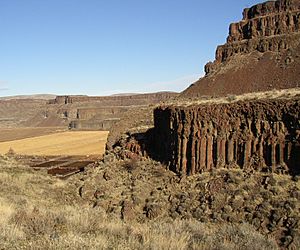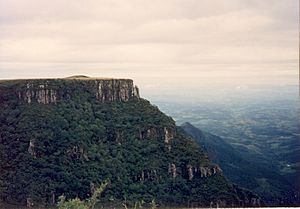Flood basalt facts for kids

A flood basalt (also called a trap basalt) happens when a huge volcanic eruption or many eruptions cover a very large area of land or the ocean floor with basalt lava. These events are so big that they can cover areas as large as a whole continent. Over time, they create huge plateaus and even mountain ranges.
Flood basalts have happened many times throughout Earth's history. They show us that our Earth has periods of very high activity, not just a steady, unchanging state.
One idea for how flood basalts form is that they are caused by a mix of continental rifting (when land pulls apart) and the melting of rocks deep underground. Then, a special area called a mantle plume brings up huge amounts of magma (melted rock). This magma is very runny, which is why it 'floods' across the land instead of building tall volcanoes.
This magma starts very deep, between 100 and 400 kilometers below the surface, in a layer called the asthenosphere. To get so much melted rock, a lot of heat is needed. This melting can happen near a hotspot, mixing magma from deep inside the Earth with magma closer to the surface.
Contents
What are Lava Plateaus?
A lava plateau is a flat, wide area of land that forms when lava flows out of the ground and spreads out quickly. Over many eruptions, layers of lava build up, making the plateau bigger and higher.
How Lava Plateaus Form
- They are very large areas covered by basaltic lava, which means they are made of many layers.
- Each new eruption adds more lava, making the plateau grow in size and height.
- Lava plateaus are usually very flat on top.
- Eruptions along mid-ocean ridges create large, flat plains on the ocean floor.
- The lava that forms these plateaus is thin and flows easily.
- It can take millions of years for these huge plateaus to fully form.
- Many eruptions from cracks in the Earth (called fissure eruptions) in the same area can build up a very high plateau over time.
Famous Examples of Flood Basalts
Many large areas around the world are covered by ancient flood basalts. Some well-known examples include:
- The Emeishan Traps in southwestern China, near Sichuan province.
- The Deccan Traps in central India.
- The Siberian Traps in Russia.
- The Columbia River Plateau in western North America.
The two largest flood basalt events that have happened in more recent history were at Eldgjá and Lakagigar, both found in Iceland. The biggest and best-preserved continental flood basalt area on Earth is part of the Mackenzie Large Igneous Province in Canada.
Even the dark, flat areas on the Moon (called the maria) are actually even larger flood basalts! Flood basalts on the ocean floor create huge, flat areas called oceanic plateaus.
The area covered by a single flood basalt eruption can be huge, from about 200,000 square kilometers (like the Karoo event) to 1,500,000 square kilometers (like the Siberian Traps). The thickness of these lava layers can also vary greatly, from 2,000 meters (Deccan Traps) to 12,000 meters (under Lake Superior). These numbers are smaller than the original amounts because of erosion over millions of years.
Another famous example of a lava plateau is the Giant's Causeway in County Antrim, Northern Ireland. This was once part of a massive volcanic plateau called the Thulean Plateau.
Images for kids
-
Ethiopian Highlands basalt
-
Multiple flood basalt flows of the Chilcotin Group, British Columbia, Canada
See also
 In Spanish: Basalto de inundación para niños
In Spanish: Basalto de inundación para niños







